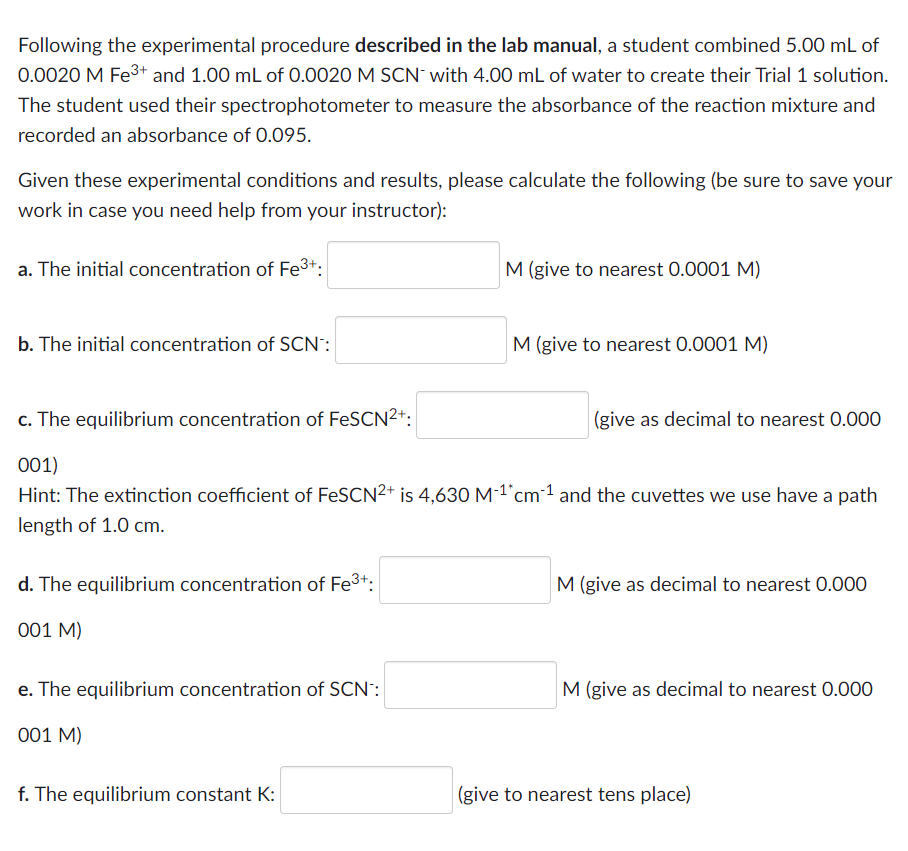Following the experimental procedure described in the lab manual, a student combined 5.00 mL of 0.0020 M Fe³+ and 1.00 mL of 0.0020 M SCN¯ with 4.00 mL of water to create their Trial 1 solution. The student used their spectrophotometer to measure the absorbance of the reaction mixture and recorded an absorbance of 0.095. Given these experimental conditions and results, please calculate the following (be sure to save you work in case you need help from your instructor): a. The initial concentration of Fe3+: M (give to nearest 0.0001 M) b. The initial concentration of SCN': M (give to nearest 0.0001 M) c. The equilibrium concentration of FeSCN2+: (give as decimal to nearest 0.000 001) Hint: The extinction coefficient of FeSCN2+ is 4,630 M-1°cm-1 and the cuvettes we use have a path length of 1.0 cm. d. The equilibrium concentration of Fe3+: M (give as decimal to nearest 0.000 001 M) e. The equilibrium concentration of SCN': M (give as decimal to nearest 0.000 001 M) f. The equilibrium constant K: (give to nearest tens place)
Following the experimental procedure described in the lab manual, a student combined 5.00 mL of 0.0020 M Fe³+ and 1.00 mL of 0.0020 M SCN¯ with 4.00 mL of water to create their Trial 1 solution. The student used their spectrophotometer to measure the absorbance of the reaction mixture and recorded an absorbance of 0.095. Given these experimental conditions and results, please calculate the following (be sure to save you work in case you need help from your instructor): a. The initial concentration of Fe3+: M (give to nearest 0.0001 M) b. The initial concentration of SCN': M (give to nearest 0.0001 M) c. The equilibrium concentration of FeSCN2+: (give as decimal to nearest 0.000 001) Hint: The extinction coefficient of FeSCN2+ is 4,630 M-1°cm-1 and the cuvettes we use have a path length of 1.0 cm. d. The equilibrium concentration of Fe3+: M (give as decimal to nearest 0.000 001 M) e. The equilibrium concentration of SCN': M (give as decimal to nearest 0.000 001 M) f. The equilibrium constant K: (give to nearest tens place)
Principles of Instrumental Analysis
7th Edition
ISBN:9781305577213
Author:Douglas A. Skoog, F. James Holler, Stanley R. Crouch
Publisher:Douglas A. Skoog, F. James Holler, Stanley R. Crouch
Chapter1: Introduction
Section: Chapter Questions
Problem 1.11QAP
Related questions
Question
Problems D,E,F

Transcribed Image Text:Following the experimental procedure described in the lab manual, a student combined 5.00 mL of
0.0020 M Fe3+ and 1.00 mL of 0.0020 M SCN with 4.00 mL of water to create their Trial 1 solution.
The student used their spectrophotometer to measure the absorbance of the reaction mixture and
recorded an absorbance of 0.095.
Given these experimental conditions and results, please calculate the following (be sure to save your
work in case you need help from your instructor):
a. The initial concentration of Fe3+:
M (give to nearest 0.0001 M)
b. The initial concentration of SCN:
M (give to nearest 0.0001 M)
c. The equilibrium concentration of FeSCN2*:
(give as decimal to nearest 0.000
001)
Hint: The extinction coefficient of FeSCN2+ is 4,630 M-1°cm 1 and the cuvettes we use have a path
length of 1.0 cm.
d. The equilibrium concentration of Fe3+:
M (give as decimal to nearest 0.000
001 M)
e. The equilibrium concentration of SCN:
M (give as decimal to nearest 0.000
001 M)
f. The equilibrium constant K:
(give to nearest tens place)
Expert Solution
This question has been solved!
Explore an expertly crafted, step-by-step solution for a thorough understanding of key concepts.
This is a popular solution!
Trending now
This is a popular solution!
Step by step
Solved in 2 steps with 2 images

Knowledge Booster
Learn more about
Need a deep-dive on the concept behind this application? Look no further. Learn more about this topic, chemistry and related others by exploring similar questions and additional content below.Recommended textbooks for you

Principles of Instrumental Analysis
Chemistry
ISBN:
9781305577213
Author:
Douglas A. Skoog, F. James Holler, Stanley R. Crouch
Publisher:
Cengage Learning


Chemistry & Chemical Reactivity
Chemistry
ISBN:
9781337399074
Author:
John C. Kotz, Paul M. Treichel, John Townsend, David Treichel
Publisher:
Cengage Learning

Principles of Instrumental Analysis
Chemistry
ISBN:
9781305577213
Author:
Douglas A. Skoog, F. James Holler, Stanley R. Crouch
Publisher:
Cengage Learning


Chemistry & Chemical Reactivity
Chemistry
ISBN:
9781337399074
Author:
John C. Kotz, Paul M. Treichel, John Townsend, David Treichel
Publisher:
Cengage Learning

Chemistry & Chemical Reactivity
Chemistry
ISBN:
9781133949640
Author:
John C. Kotz, Paul M. Treichel, John Townsend, David Treichel
Publisher:
Cengage Learning
